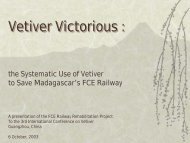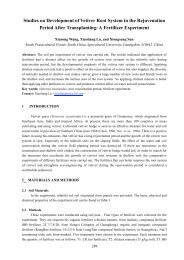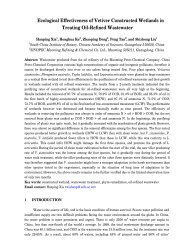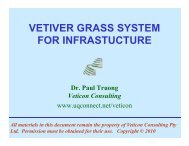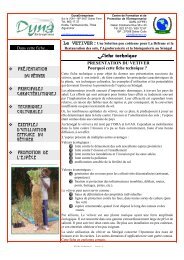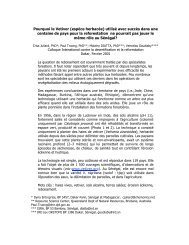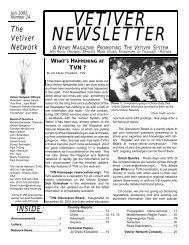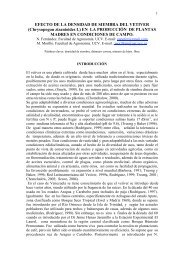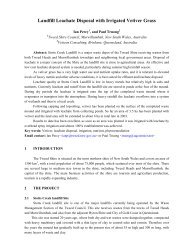Training manual - The Vetiver Network International
Training manual - The Vetiver Network International
Training manual - The Vetiver Network International
Create successful ePaper yourself
Turn your PDF publications into a flip-book with our unique Google optimized e-Paper software.
emoving the young vetiver plant out for planting. Instead, the polybags are left in the field, thus<br />
creating environmental pollution.<br />
Demand-Supply Problem: In many cases, the demand for vetiver planting material does<br />
not match the supply. Sometimes a large number of polybags with vetiver is available at the<br />
multiplication center while the demand for them is much less. As a result, most of them are to be<br />
disposed of, since they are no longer good for planting a few months after their optimum period (of<br />
45 days). In other occasion, there is not enough planting material at the time of need.<br />
Labor Intensifies: Starting from procurement of medium (topsoil, burnt rice husk, coir<br />
dust, and compost), cutting the corner edges of the polybags, filling the medium into the polybag,<br />
preparing the tillers, inserting the tillers in the polybags, laying the polybags in the nursery,<br />
watering and other maintenance, transporting the polybags to the field, removing the polybags,<br />
digging holes for planting, placing the vetiver plants in the hole, covering the holes with soil,<br />
collecting used polybags, etc., all are quite time- and labor-consuming.<br />
Even with all the above drawbacks, planting tiller in polybag is still popularly employed in<br />
vetiver propagation in most vetiver-growing countries, as it is the most practical method of<br />
propagation.<br />
5.3.2.3 Types of polybag Propagation: Planting vetiver in the polybags is both clean<br />
and easy to maintain; however, it requires proper tools for watering and caring. Depending on the<br />
objective, two sizes of polybags are used: small polybags for field planting, and large polybags for<br />
multiplication.<br />
In Small Polybags for Field Planting: This method is appropriate to be used under various<br />
development projects in the initial stage of operation. It is very convenient in terms of distribution<br />
and providing services or support to various agencies and interested public for further multiplication<br />
or other purposes. It is easy to develop and keep a record of the number of bags and tillers needed to<br />
meet the demand.<br />
<strong>The</strong> size of the polybags is about 5 cm wide and 15 cm long, with a diam. of 7 cm when filled<br />
with soil. Many other sizes have also been used in several countries. <strong>The</strong>y are suitable for direct<br />
transplanting on land or specific areas for soil and water conservation purposes, such as in<br />
hedgerows on roadsides and road shoulders, at pond edges, and on paddy buns to hold the soil in<br />
dry, impoverished and saline conditions. Planting vetiver tillers propagated in small plastic bags<br />
ensures a better survival rate and faster establishment of the vetiver grass than conventional bareroot<br />
planting.<br />
In Large Polybags for Multiplication: <strong>The</strong> large polybag is made of black polyethylene,<br />
about 10 cm wide and 25 cm long, with folding at the bottom. When filled with planting soil, the<br />
bag will have a diameter of 15-20 cm. Propagation of vetiver tillers in large polybags can produce a<br />
large number of new shoots. <strong>The</strong>se shoots are collectively called clump and can be kept in the<br />
polybags for an extended period of time. Hence, these vetiver clumps are suitable for further<br />
multiplication or for separating into individual tillers (bare root) for large-scale transplanting.<br />
5.4 Innovative Techniques in <strong>Vetiver</strong> Propagation<br />
As planting vetiver for soil and water conservation is getting popular, many new innovative<br />
techniques of its propagation have been developed to obtain better result in a shorter period of time<br />
with less expense. Among these are:<br />
37




